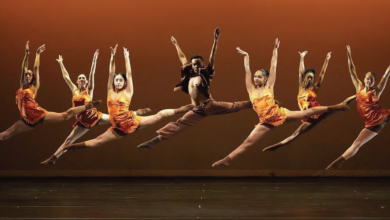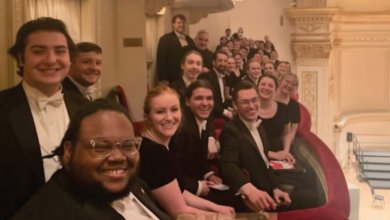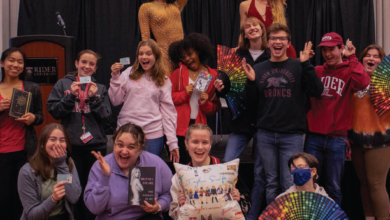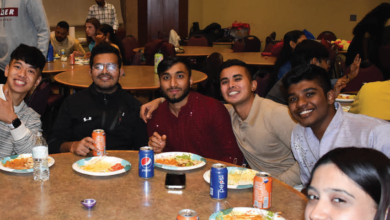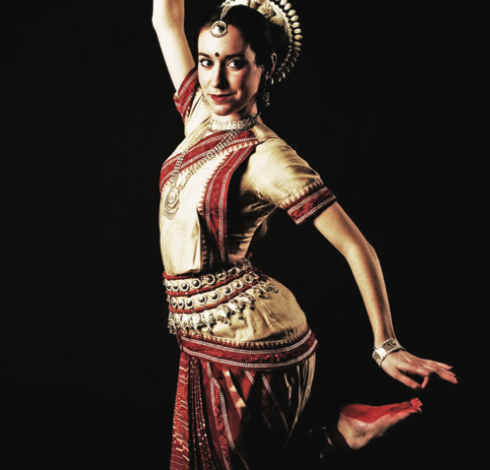
Rider professor shares her love for traditional Indian dance
By Felicia Roehm
Professor Merli V. Guerra wore a red and beige pleated skirt called a fan while trying not to sweat under the sweltering lights. Her costume was made out of silk and a silver, sparkly belt was wrapped tightly around her waist. She had silver jewelry on her wrists and neck with a large, round, white headdress secured to the back of her head in her dark brown hair. Her nails were bright red, matching the accent color on her ensemble which is mainly the color of sand.
Guerra’s movements were grounded in the floor while the scarlet red paint on the bottom of her feet seeped into the stage’s floor with every stomp. The bells that covered her ankle rang with every step on the dark black stage floor. Her one arm was raised with her index finger touching her thumb. Guerra’s other arm was lowered to her chest with her hand in a fist. With every move she made, she was telling a story. The narrative was told through her small, defined ruby lip curved to the left with her right eyebrow raised. Guerra’s left hip was lifted, and her expression looked fierce.
Guerra was performing a traditional Indian dance called Odissi.
“Originally it started as a temple dance and it was devotional to the gods of that temple, and that is why we wear these headdress piece,” Guerra said. “All of that costuming, jewelry and the headdress that we wear is pertaining back to when we were temple dancers.”
When the dance form began in the temple, it was looked at as an honorable way of expression until colonization when the Odissi dancers were driven out. The dancers had nowhere to go and turned to prostitution. Many years later, when people wanted the dance form to return to being seen in a positive way, most of the Odissi dancers had passed away. For it to be resurrected, people had to go back to the older dancers who were still alive and look at the original temples and seeing the sculptures of the Odissi dancers helped them learn the dance moves in its true form.
During Guerra’s freshman year of college at Mt. Holyoke College as a dance major, she took a beginner classical Indian dance class taught by Guru Ranjanaa Devi and fell in love with the art form of a culture she had no prior experience with.
“I had only ever done ballet previously. That was my strict upbringing, and I was really amazed by how emotional and expressive the facial expressions were in this dance form, and my use of hands, that was really different for me from ballet,” Guerra said. “The fact that I had to weigh myself into the ground opposed to pulling myself up out of the ground, it was a huge transition for me.”
Near the end of the semester, Guerra asked Devi if she teaching anymore classes. Devi wasn’t teaching anymore classes at Mt. Holyoke College, but was teaching at the University of Massachusetts nearby.
It was a year-long class to learn all about the history of India, including politics and culture. Devi told Guerra to take the class because she wanted Guerra to learn the history of Indian dance before continuing to learn anymore of the dance style itself. Guerra took the year-long class and went to India to study these different dance forms.
When the year ended, Devi invited Guerra to join her company, Nataraj: Performing Arts of India in Amherst, Massachusetts. She performed many times with the company, and when Guerra graduated in 2009, the company was invited to perform on tour in Japan with the dance company Kitanodai Gagakukai. She was one of four invited to go on tour. After the tour, Guerra was still actively performing with the company until 2017.
Odissi is the only classical Indian dance form that uses silver jewelry. In every other form of Indian dance, the dancers are dressed in gold. In Odissi, the musician and the dancer do a call and response. If the musician plays a song, then the dancer can respond using their ankle bells and footwork. Odissi dancers also paint their hands and the bottom of their feet so no matter where a person is sitting in the audience, the audience member can see the performers hands and feet clearly. “We do that with the intention of being able to really extend our hands and our feet and have people see them from further away because the hands, the mudras, are so important,” said Guerra. “Those are super important for storytelling purposes, and then our feet are really important for the rhythm. We also have ankle bells that help emphasize that rhythm as we perform.”
The mudras are symbols made with someone’s hands to portray a mood or emotion. There are similarities between Odissi’s mudras and American Sign Language (ASL). Guerra explained that she once had a student that was fluent in ASL and told Guerra that in both Odissi and ASL, sweeping the hand across the face means beautiful. Guerra said, “There are some similarities there that are really interesting to me, like, we’ve come to this from two different continents and two different sources like American Sign Language and classical Indian dance.”
Rider alumna Tanisha Anand, who majored in dance, is from Delhi, India, has been learning Bollywood dance since she was in the second grade. She grew up watching Bollywood movies and describes it as, “musical theater on camera.” In Bollywood, the dancers are moving a certain way to depict what the situation is in the movie. Anand said she loves, “the energy, the rhythm and of course expressions. I do
not like expressionless dancing, and I think if you’re communicating a message through your dancing, there should be facial expressions for sure.”
She loves Bollywood because there is no set technique. In Bollywood, the main goal is to have fun. Anand said, “There is diversity in your expressions, there is diversity of what story you are trying to tell, the costumes are colorful, the music and the rhythm is different.” She has continued Bollywood and other forms of Indian dance since graduating.
Junior arts and entertainment industry management student Megyn Kukulka, who minors dance that utilizes silver jewlery rather than the usual gold. in dance, was first introduced to classical Indian dance her freshman year when she took a history of choreography class taught by Guerra. Kukulka had no previous knowledge of classical Indian dance and said, “Traditional Indian dance was really interesting to learn because it is very different than any other form I have ever learned. It is very intricate with the hand movements, but then also very grounded in the steps. It is also a lot about telling stories through movement, which is a lot similar to everything I’ve done in the past, except it’s more about emoting with pictures rather than with just overall emotional movement.”
Kukulka learned traditional Indian dance again last year in World Dance and Improvisation taught by Guerra. Learning it a second time, she explained she felt more prepared.
“It was a lot of fun to kinda step back into it. It was just almost like a different experience because I was surrounded by different people and I really enjoyed it,” Kukulka said. She recommends learning about different cultures and trying something new from someone experienced.
In 2010, Guerra opened her own dance company in Boston, but still continued performing with Nataraj: Performing Arts of India. Her dance company is called Luminarium Dance Company, luminarium meaning “to give off light or to enlighten mankind.” Her company is award-winning, and focuses on nontraditional lighting design. She is also a writer, award winning filmmaker, and teaches Odissi at Rutgers University. Guerra said, “I love how expressive it is, I love the storytelling nature of it and I like that I can be kinda sassy as I’m performing it. There’s this posturing that I can do where it’s like I’m telling you this story and I can be very emotive with the different characters that are involved. That’s the part that I like, the acting.”
